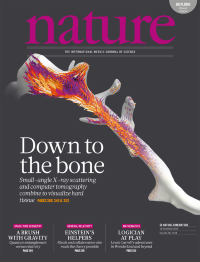Volume 527
-
No. 7579 26 November 2015
The Paris climate conference, opening on 30 November and scheduled to run to 11 December, is the focus of considerable optimism. The 190 nations attending are each expected to announce steps that would limit climate change. But as this special issue of Nature makes clear, history offers a sobering lesson: the quest to build a global climate treaty stretches back for quarter of a century with little success. Its dramatic story is chronicled in comic form on page 427. Online, Nature presents a package of videos exploring aspects of the climate summit, as well as other unique material, available at www.nature.com/parisclimate. Cover credit: David Parkins.
Nature Outlook
-
No. 7578 19 November 2015
Ultrastructure and collagen fibril orientation in a human trabecular bone sample, determined by three-dimensional small-angle X-ray scattering. Small-angle X-ray scattering (SAXS) can, in principle, probe structural ordering across a wide range of length scales, from nanoscale to the macroscopic. However, an experimental method and analysis scheme to obtain three-dimensional images while preserving nanostructure orientation information remained out of reach. Two papers in this issue of Nature combine different tomographic principles with SAXS to yield this information. Marianne Liebi et al. introduce a generally applicable model that can describe the SAXS data and show how taking account of the symmetries intrinsic to many samples of interest � such as the preferred orientation of collagen fibrils in the human trabecular bone that they have studied � can make the process more manageable. The procedure demonstrated by Florian Schaff et al. introduces the concept of virtual tomography axes, which allows arrangement of the vast amount of data to enable a direct independent reconstruction of each reciprocal space component. For their example, they show the orientation and scattering strength of mineralized collagen in a human tooth, spatially resolved over several millimetres. Cover credit: Marianne Liebi.
Collection
-
No. 7577 12 November 2015
A hollow log hive in the Cvennes mountains, France, showing circular honeycomb architecture characteristic of the honeybee Apis mellifera. Bees and humans have enjoyed a long association, as evidenced by bee iconography in rock art and ancient Egyptian paintings and carvings, and a few isolated reports of beeswax in archeological contexts. But when did this association become common? Mlanie Roffet-Salque et al. use the telltale gas chromatographic signature of beeswax from lipid residues preserved in pottery vessels to plot the use of beeswax across Neolithic Europe, the Middle East and North Africa. They demonstrate its extensive and possibly continuous use in some places for 8,000 years or more. The association, therefore, goes back to the beginnings of agriculture and possibly earlier. Cover photo: Eric Tourneret (http://thebeephotographer.photoshelter.com)
Nature Index
-
No. 7576 5 November 2015
A representation of two alternative scenarios for the Australian economy to 2050. For a developed nation to move to a sustainable society requires simultaneous rebalancing of economics, energy, agriculture and behaviour. Steve Hatfield-Dodds et al. use a multimodel framework to assess the ability to achieve this within a single nation-continent, Australia. Looking at climate, water, food, energy and biodiversity, they show that economic improvement is possible without ecological deterioration, but that specific political and economic choices need to be made to achieve this. Cover art: Emily Cooper.
Nature Outlook




